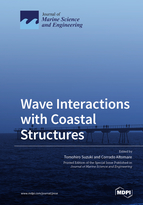Wave Interactions with Coastal Structures
A special issue of Journal of Marine Science and Engineering (ISSN 2077-1312). This special issue belongs to the section "Coastal Engineering".
Deadline for manuscript submissions: closed (5 July 2021) | Viewed by 38290
Special Issue Editors
2. Dept. of Hydraulic Engineering, Delft University of Technology, Stevinweg 1, 2628 CN Delft, The Netherlands
Interests: wave-structure interaction; wave-vegetation interaction; wave hydrodynamics; coastal safety; numerical modeling; physical modeling
Special Issues, Collections and Topics in MDPI journals
Interests: coastal engineering; computational fluid dynamics; smoothed particle hydrodynamics
Special Issues, Collections and Topics in MDPI journals
Special Issue Information
Dear Colleagues,
Due to the ongoing rise in sea level and changing wave climate, coastal structures such as sea dikes and seawalls are expected to be more frequently exposed to more severe wave climates. Even though much research related to wave–structure interactions has been carried out, it still remains one of the most important topics in the field of coastal engineering. The outcomes of research will lead to improvements in safety, environmental impact, and the cost efficiency of construction.
For this Special Issue, we invite papers which present theoretical/mathematical, experimental, or numerical work related to wave interactions with coastal structures. This Special Issue is dedicated to the topic of wave interactions with conventional coastal hard structures. However, details and new outcomes related to constructions located in wave-affected zones, such as apartment buildings on dikes or other infrastructures, and also with soft structures such as nature-based solutions, are also welcome.
Dr. Tomohiro Suzuki
Dr. Corrado Altomare
Guest Editors
Manuscript Submission Information
Manuscripts should be submitted online at www.mdpi.com by registering and logging in to this website. Once you are registered, click here to go to the submission form. Manuscripts can be submitted until the deadline. All submissions that pass pre-check are peer-reviewed. Accepted papers will be published continuously in the journal (as soon as accepted) and will be listed together on the special issue website. Research articles, review articles as well as short communications are invited. For planned papers, a title and short abstract (about 100 words) can be sent to the Editorial Office for announcement on this website.
Submitted manuscripts should not have been published previously, nor be under consideration for publication elsewhere (except conference proceedings papers). All manuscripts are thoroughly refereed through a single-blind peer-review process. A guide for authors and other relevant information for submission of manuscripts is available on the Instructions for Authors page. Journal of Marine Science and Engineering is an international peer-reviewed open access monthly journal published by MDPI.
Please visit the Instructions for Authors page before submitting a manuscript. The Article Processing Charge (APC) for publication in this open access journal is 2600 CHF (Swiss Francs). Submitted papers should be well formatted and use good English. Authors may use MDPI's English editing service prior to publication or during author revisions.
Keywords
- waves
- coastal structures
- hydrodynamics
- wave overtopping
- wave force
- infrastructures
- nature-based solutions







